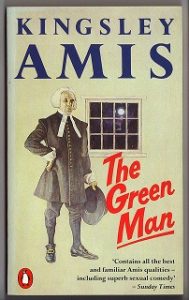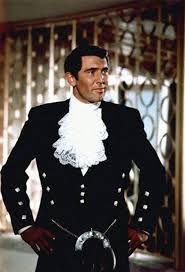
© Penguin Books
And here’s another re-posting in anticipation of Halloween, one that originally appeared on this blog seven years ago. This time, I offer my thoughts on Kingsley Amis’s ghostly novel of 1969, The Green Man.
I can claim to be neither an expert on nor a fan of Kingsley Amis. While I’ve enthusiastically worked my way through the fiction of several of his contemporaries – Anthony Burgess, William Golding, Graham Greene – until recently I’d read only a couple of Amis’s short stories and one of his books, Lucky Jim. The latter was an early (1954) example of the literary sub-genre now known as the ‘campus novel’ and I have to say I found it pretty dated and unfunny.
I suspect the main reason for my aversion to Kingsley Amis, though, is the persona he projected when he was alive. He didn’t seem like a nice piece of work and so I rarely felt an urge to dip into his writing. In the 1950s he trumpeted his support for the Labour Party but by the 1980s he’d become an enthusiastic fan of Mrs Thatcher. He seemed to me pretty typical of people whose politics undergo a severe rightward turn during their lifetimes. Socialist egalitarianism and liberal permissiveness are great things when you have youth, and a lack of material possessions, on your side. But when you reach a point in your life when you’re too old, and too moneyed, to benefit from them any longer, and when a younger, upstart generation arrives on the scene with their own ideas about how to do things, it’s time to change into a reactionary old fart and whinge about other people being radical in a way you once were yourself.
But far worse than Amis’s Conservatism was the fact that in later years he seemed unashamedly anti-Semitic, racist and misogynistic. I’ve read an interview with his long-suffering second wife Elizabeth Jane Howard in which she, rather gallantly, blamed much of that nastiness not on Amis but on his fondness for alcohol. In other words, his odiousness was really just the drink speaking. However, I can’t help thinking of an old saying they have in Northern Ireland: “If it’s not in you when you’re sober, it won’t come out of you when you’re drunk.”
Still, I have one reason for liking Amis, and that’s because unlike nearly everyone else in Britain’s snobbish literary establishment at the time, he didn’t look down his nose at genre writing. He was openly supportive of it and occasionally dabbled in it himself. For example, Amis was one of Ian Fleming’s most heavyweight admirers and it’s fitting that, after Fleming’s passing, he was the first person to write a non-Fleming James Bond novel, Colonel Sun, which he published in 1968 under the pseudonym Robert Markham.
Amis was also a big fan of science fiction and in 1960 he wrote a critique of the genre, New Maps of Hell. As J.G. Ballard noted, New Maps of Hell was important for science fiction’s development because Amis “threw open the gates of the ghetto, and ushered in a new audience which he almost singlehandedly recruited from those intelligent readers of general fiction who until then had considered science fiction on par with horror comics and pulp westerns.” Predictably, though, the curmudgeonly Amis went off science fiction in the 1960s when younger sci-fi writers like Ballard, Brian Aldiss, Michael Moorcock, Roger Zelazny, Harlan Ellison and Thomas M. Disch started going all experimental and New Wave-y on him. Before long, he was raging at how those whippersnappers had contaminated his beloved science fiction with horrible things like “pop music, hippie clothes and hairdos, pornography, reefers” and “tricks with typography, one-line chapters, strained metaphors, obscurities, obscenities, drugs, Oriental religions and left-wing politics.”
Amis seemed too to be interested in supernatural stories and in 1969 he tried his hand at writing one, a novel called The Green Man. This has long been a neglected entry in Amis’s oeuvre, overshadowed by more prestigious books like Jake’s Thing (1978) and The Old Devils (1986), out of print and near impossible to find in bookshops. It was, however, adapted into a three-part drama serial by the BBC in 1990, with the script written by none other than Malcolm Bradbury, an author whose own books like Eating People is Wrong (1959) and The History Man (1975) were examples of the campus novel that Amis had helped pioneer with Lucky Jim. The TV version of The Green Man starred the splendid Albert Finney and it began with a memorable and grisly sequence that didn’t evoke Kingsley Amis, or Malcolm Bradbury, so much as it evoked Sam Raimi’s 1981 classic schlock-horror movie The Evil Dead.

© A&E Television Productions / BBC
Anyway, I enjoyed the televisual The Green Man so much that I made a mental note to set aside my prejudices against Amis and hunt down the original novel of The Green Man. It wasn’t until nearly a quarter-century later, however, that I noticed a new edition of The Green Man sitting on a shelf in a bookshop, bought it and finally got around to reading it. So here are my thoughts about this particular foray by Kingsley Amis into the realms of the paranormal and macabre.
The Green Man is narrated by the fifty-something Maurice Allington, the character played by Albert Finney in its TV adaptation. He owns and runs an inn of some antiquity, the titular Green Man, on the way from London to Cambridge. Living on the premises with his second wife Joyce (his junior by a number of years), his teenage daughter Amy and his ailing father, Allington is unnerved when the hoary old ghost stories associated with the inn over the centuries start to intrude on reality. In particular, he has several encounters with the ghost of Thomas Underhill, a supposed sorcerer who lived in the building in the 17th century; and he senses the presence of a more monstrous apparition, a demonic creature that Underhill once summoned up from the local woods to destroy his antagonists. The inn’s name is a clue to this demon’s constitution.
Allington eventually realises he’s become enmeshed in a scheme that Underhill has devised to transcend his own death. However, his attempts to outwit the ghostly sorcerer are hampered by his own failings: his ill-health, his liking for the bottle – to which, of course, his family and friends attribute his strange visions – and the distractions posed by his carnal appetites. Not only is the lusty Allington engaged in an affair with another younger woman, Diana, who’s the wife of the local doctor, but he’s devised a less-than-noble scheme of his own. He wants to persuade both Joyce and Diana to participate with him in a ménage à trois.
I hadn’t got far into The Green Man before I’d realised that both the book’s greatest strength and its greatest weakness are its characterisations. Amis does an excellent job of sketching Allington, with his many vices and virtues. He’s annoyingly conceited, intellectually as well as socially. Talking about his book collection, he says sniffily: “I have no novelists, finding theirs a puny and piffling art, one that, even at its best, can render truthfully no more than a few minor parts of the total world it pretends to take as its field of reference. A man has only to feel some emotion, any emotion, anything differentiated at all, and spend a minute speculating how this would be rendered in a novel… to grasp the pitiful inadequacy of all prose fiction to the task it sets itself.” Allington, thus, is a poetry snob. “By comparison… verse – lyric verse, at least – is equidistant from fiction and life, and is autonomous.”
Actually, his love for the poetic and his disdain for the more mechanical medium of prose remind me slightly of the late 19th century / early 20th century occult writer Arthur Machen, who speculated in his fiction that supernatural phenomena are best perceived by people with receptive intellects and imaginations. These include the very young, the insane and the poetically-inclined. Perhaps that’s why, of all the people living, dining and drinking in the Green Man, the verse-loving Allington is the one with whom the supernatural intelligence of Thomas Underhill makes contact.
Meanwhile, feminist readers will no doubt feel like strangling Allington on account of his baser musings. “Ejaculation,” he comments at one point, “as all good mistresses know, is a great agent of change of mind and mood.”
And yet as a bundle of contradictory traits – stuck-up, sexist, cynical, drunken, cranky, comical, cunning, occasionally courageous and very occasionally principled – Allington is a believable figure in this story. He might be an unfortunate mess of vanity, lust and booze, but at the book’s finale, when he rushes out of the inn and into the night to try to save the sleepwalking Amy from the predatory green man, we aren’t surprised that he shows a streak of heroism as well.
But on the other hand, Amis is hopeless at drawing believable female characters here. Joyce and Diana give little impression of having minds of their own. They seem like manifestations of Amis’s notion of what women should be like – statuesque, well-bred and utterly pliable to the needs of the local Alpha Male. “Together,” says Allington, “they made an impressive, rather erectile sight, both of them tall, blonde and full-breasted… Dull would he be of soul that would pass up the chance of taking the pair of them to bed.” In their speech, meanwhile, they spout irritating upper-class adverb-adjective couplings: “jolly closed up”, “perfectly awful”, “frightfully exciting”, “damn good”. Late on in the book, Allington’s devious ménage à trois plan backfires and Joyce and Diana get their revenge on him, but this isn’t enough to convince me that they’re anything more than Kingsley Amis’s idea of desirable posh totty.

From artinfiction.wordpress.com
Elsewhere in the book, predictably, we’re treated to a list of things in the modern (or at least, 1960s-ish) world that the grumpy, ageing Amis finds appalling. He sounds off against radical students: “First one whiskered youth in an open frugiferous shirt, then another with long hair like oakum, scanned me closely as they passed, each slowing almost to a stop the better to check me for bodily signs of fascism, oppression by free speech, passive racial violence and the like.” He rails against popular music: “Amy’s gramophone was playing some farrago of crashes, bumps and yells from her room down the passage… I listened, or endured hearing it…” He has a go at trendy vicars: “I found it odd, and oddly unwelcoming too, to meet a clergyman who was turning out to be, doctrinally speaking, rather to the left of a hardened unbeliever like myself.” Readers will either find this aggravating or endearing. Now that Amis has been dead for a quarter-century and I’m in the process of turning into a grumpy old man myself, I have to confess I found it rather endearing – more so than I would have if I’d read the novel in my youth.
Failures in female characterisation aside, I generally enjoyed The Green Man and I had more fun reading it than I had with Lucky Jim. However, is the novel successful as a ghost story? In my opinion, for a ghost story to succeed, it needs to convey a degree of believability. If I can be lulled into thinking, however fleetingly, that this could be happening, I’m more likely to be affected, unsettled, even frightened by it. On this account, Amis’s book almost succeeds. For the most part, he convincingly moves the plot from being about a man whose home has some strange old tales attached to it to being about a man who has to deal with the unwelcome, ghostly protagonists of those tales. To facilitate this jump from the credible to the incredible, Amis adds some persuasive background details. A section where Allington visits a library at Cambridge University in search of a long-lost journal by Underhill has a scholarly believability that’s worthy of M.R. James.
Alas, all is betrayed by a scene near the novel’s climax where Amis goes too far and introduces another supernatural character, the most famous and powerful supernatural character of the lot – guess who that is. Now any story involving ghosts has implications about the wider scheme of things. It makes life after death a fact, which raises questions about the design and purpose of the universe and about the intelligence that might be behind it. However, for the sake of believability, it’s advisable for ghost-story writers to keep things localised and small-scale. In M.R. James’s celebrated short story Oh, Whistle, and I’ll Come to You, my Lad, for example, what’s important is that the hero is being pursued along a beach by a terrifying supernatural entity. Not that this entity’s existence calls into question our scientific assumptions about the universe – because if it does exist, then scientists are likely wrong and the priests, magicians and shamans of history were likely right.
Amis, unfortunately, can’t resist exploring the universe he’s created in The Green Man further than is necessary and so Allington ends up having an unexpected visit from the Big Man Upstairs. Their confrontation resembles something from the classic 1946 Michael Powell / Emeric Pressburger fantasy movie, A Matter of Life and Death. And that’s what The Green Man promptly becomes, a fantasy rather than a ghost story – a story that’s no longer believable and hence no longer scary.
J.G. Ballard once said of Kingsley Amis: “as with so many English novelists he was vaguely suspicious of the power of the imagination: it could be too much of a good thing. Yet the radical imagination is what we seek in a writer; when we read we want to encounter a very different world that will make sense of our own.”
Ironically, the problem with The Green Man is that in the end, and atypically, Amis lets his own imagination run away with him. The book would have been more effective if, like those English novelists whom Ballard complains about, he had decided that too much imagination here is a bad thing.

© David Smith / From the Guardian






